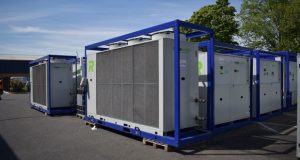Poor quality air takes a significant toll on both the economy and people’s health. But there is an effective remedy, says Mark Taylor of Camfil
Air pollution is the foremost environmental cause of early death, contributing to the equivalent of five per cent of all fatalities around the world. In the UK, long-term exposure to particulate air pollution has led to the equivalent of 29,000 deaths a year.
In 2017, two of the main airborne pollutants – particulate matter and nitrogen dioxide – cost the NHS and social care in England almost £43 million. And the total healthcare cost of air pollution is expected to be £1.6 billion between 2017 and 2025 – enough to buy around 32 million respirator masks.
Decent air quality, on the other hand, can boost productivity in offices by 10 per cent and cut sickness absence by 39 per cent. Quite apart from the moral imperative to look after people, these sorts of gains make good indoor air quality (IAQ) a high priority for hard-pressed businesses looking to increase output and reduce costs.
So, what can the facilities manager do to help improve the quality of the air breathed by building occupants?
There is an inherent link between indoor and outdoor air quality, so preventing bad air from entering the building in the first place should be the top priority. Filters form a vital first line of defence against air pollution. As building envelopes have become increasingly airtight because of the requirements of energy efficiency, so it has become more practical to treat them as ‘safe havens’ from dirty outside air. Air filtration is integral to this because it can provide impressive air cleaning capabilities.
A well-sealed building envelope and effective filtration of the incoming air supply can reduce particle penetration by 78 per cent. However, indoor air contamination can be up to 10 times worse than outside air, partly because the pollution is trapped, but also because additional pollutants are generated from carpets, photocopiers and other interior sources.
The human body has natural defences against dirty air such as nasal hair and mucus membranes, which trap larger particles as they are breathed in. However, smaller particles can penetrate deep down into the finer structures of the lungs and will pass from the lungs into the bloodstream, reaching critical organs. Metal particles significantly smaller than one micron from diesel engines have been discovered in the human brain, and have been linked to early onset dementia.
PEOPLE MATTER
Camfil has launched a campaign to help people understand the effect of ultrafine particulate matter on their health. Called People Matter 1st, it is designed to address the problem of poor air quality by raising awareness of the dangers and proposing solutions, which include air filters to improve indoor air quality and benefit health.
To provide a truly healthy and productive indoor air environment in areas with particularly bad air pollution, ventilation systems need filters that are also capable of removing PM1 particles – the smallest and most harmful particulates which are one micrometre or smaller in diameter.
Air filters that effectively separate PM1 particles from incoming air not only protect people from serious health problems, but also help sustain general wellbeing and productivity by preventing bacteria and viruses (which are often PM1 in size) from spreading through the ventilation system.
Historically, there have been a number of air filter testing standards. In the US ASHRAE 52.2 has been dominant, and in Europe EN779 has been the leading standard. In Asia, a combination of these has been common, supplemented by an array of local standards. Now a new standard – ISO 16980 – represents a significant harmonisation of global air filter testing and classification.
There are many benefits to ISO 16890. For example, it is written into the standard that air filters will improve IAQ and benefit human health. Filter efficiency and the classification system relate to real-world air pollution, and the standard is applicable globally, helping to eliminate confusion – particularly in contracts spanning several countries.
Under ISO 16890, filter performance is measured and recorded against three particle sizes – PM10, PM2.5 and PM1. Once these measurements are obtained, the filter can be placed into one of four classifications – e (meaning efficiency) PM1-rated filters; ePM2.5; ePM10 and, for low-performing filters, there is a ‘coarse’ category.
For air filter testing, there is a methodology for loading a filter with artificial dust in the laboratory so that you can see how the pressure drop curve develops, giving an indication of energy consumption and lifetime. Under the new ISO standard, that test is now much more aligned with the particle size suspended in the exterior atmosphere in big cities.
A clean, healthy environment benefits people, the economy and the bottom line. As well as being vital for people’s health and the environment, it is also essential for making sure our cities are welcoming places for people to live and work now and in the future.
⇒ In 2018, a Clean Air Bill was introduced in the House of Lords by Baroness Jenny Jones, a Green Party peer. Drafted in collaboration with Clean Air London, the bill aims to enshrine the right to breathe clean air into UK law. If passed, the bill – which covers both outdoor and indoor air pollution – will enable people and communities to defend their right to clean air in the courts, forcing councils, corporations and government bodies to take air quality seriously.
⇒ ISO 16890 is the new global air filtration standard that allows filters to be categorised on the basis of how efficiently they perform against PM10, PM2.5 and PM1 particle sizes.
⇒ ISO 10121-2 is the molecular filter test standard. It aims to provide an objective way to estimate the performance of any full-size gas filtration device for general filtration. ISO 10121 prescribes methods, test equipment, data interpretation and reporting for gas-phase air cleaning devices intended for the removal of gas-phase contamination from air in general ventilation applications.




